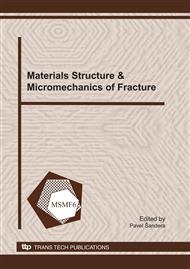p.123
p.129
p.133
p.137
p.141
p.145
p.149
p.153
p.157
The Simulation and Modelling of the Crack Path of Biomaterials
Abstract:
Analysis of issues related to the cracking process of materials requires a quantitative description of the problem which frequently, due to its complexity, is difficult or impossible to solve. In a number of cases, the deficiencies of a quantitative description made using classical methods are compensated for by such unconventional tools as percolation, which requires creating an appropriate model. The aim of the study was to use a three-dimensional minimal spanning tree (3DMST) to create a model of the crack path, based on an example of a metallic biomaterial. For this purpose, a stereometric file, obtained as a result of measuring its fracture surface, was applied.
Info:
Periodical:
Pages:
141-144
Citation:
Online since:
January 2011
Authors:
Keywords:
Price:
Сopyright:
© 2011 Trans Tech Publications Ltd. All Rights Reserved
Share:
Citation:


